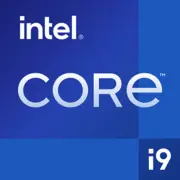Intel Core i9-9900K

Intel Core i9-9900K in 2025: Is It Worth Getting the Legendary Processor for Your Build?
Introduction
The Intel Core i9-9900K, released in 2018, has become one of the most popular processors for gamers and enthusiasts. Despite its age, in 2025, it continues to attract attention due to its availability on the secondary market and high single-core performance. But how relevant is it today? Let's break it down in detail.
1. Key Specifications: What's Under the Hood?
Architecture and Process Technology
The processor is built on the Coffee Lake microarchitecture (14 nm++), which represents the pinnacle of Intel's 14-nanometer process era. It is an 8-core chip with 16 threads (Hyper-Threading), a base frequency of 3.6 GHz, and a turbo boost of up to 5.0 GHz. The L3 cache size is 16 MB.
Performance
According to Geekbench 6 (2025):
- Single-Core Test: 1664 points — a score close to the Ryzen 5 7600X (1700-1750).
- Multi-Core Test: 7976 points — inferior to modern 12-core CPUs, but surpasses 6-core models.
Key Features
- Support for Intel Optane Memory.
- Integrated graphics UHD Graphics 630 (for emergencies or office work).
- Overclocking capabilities (with an unlocked multiplier).
2. Compatible Motherboards: What to Choose in 2025?
Socket and Chipsets
- Socket: LGA 1151 v2 (for 8th and 9th generation processors only).
- Chipsets: Z390 (optimal for overclocking), H370, B365, H310.
Choosing Tips
- Z390: Supports overclocking, PCIe 3.0 x16, USB 3.1 Gen2. Examples: ASUS ROG Maximus XI Hero (price for new boards — $200-250, but they are nearly unavailable).
- B365/H370: Budget options without overclocking.
Advice: In 2025, new motherboards for LGA 1151 v2 are rare. Look for tested models on Amazon or specialized stores (for example, ASRock Z390 Phantom Gaming 4).
3. Supported Memory: DDR4 and Its Potential
- Type: Only DDR4 (DDR5 not supported).
- Frequencies: Officially up to 2666 MHz (on H370/B365 chipsets), but on Z390 can be overclocked to 4000+ MHz.
- Recommendations: The optimal choice is DDR4-3200 CL16 (for example, Corsair Vengeance LPX 32 GB).
Why Not DDR5?
The Coffee Lake architecture does not support the new standard. Transitioning to DDR5 requires moving to AM5 or LGA 1700/1851 platforms.
4. Power Supply: How Many Watts Are Needed?
Power Consumption
- TDP: 95 W, but when overclocked (up to 5.0 GHz), consumption reaches 150-170 W.
- Recommendations:
- Without overclocking: PSUs in the 500-550 W range (for example, EVGA 500 GD).
- With overclocking: 650-750 W + overhead for the graphics card (NVIDIA RTX 4070 Ti consumes ~285 W).
Important: Choose power supplies with 80+ Gold certification (Corsair RM750x, Seasonic FOCUS GX-650).
5. Pros and Cons: Weighing the Arguments
Pros:
- High single-core performance — relevant for games and applications dependent on IPC.
- Overclocking potential — even in 2025, it is possible to push 5.0-5.1 GHz with good cooling.
- Compatibility with Windows 10/11 and Linux.
Cons:
- No PCIe 4.0/5.0 — a limitation for the speed of SSDs and graphics cards (for example, the RTX 4090 loses 5-7% performance on PCIe 3.0 x16).
- 8 cores — a bit low for rendering or streaming in 4K.
- Lack of support for DDR5 and new instructions (AVX-512).
6. Use Cases: Where the i9-9900K Still Shines
Gaming
- 1080p/1440p: Paired with RTX 3060 Ti or RX 6700 XT, it shows 60-100 FPS in AAA titles (Cyberpunk 2077, Starfield — medium settings).
- Esports Titles: CS2, Valorant — stable 200+ FPS.
Work Tasks
- Photo editors (Photoshop, Lightroom) — fast filter application.
- Programming — comfortable work in IDEs (VS Code, IntelliJ).
Multimedia
- Streaming (OBS) — sufficient for 1080p@60fps streams, but simultaneous gaming and streaming may lead to drops.
7. Comparison with Competitors
AMD Ryzen 7 5800X (8 cores/16 threads):
- Pros: PCIe 4.0 support, better in multi-threaded tasks.
- Cons: More expensive (new — $250 vs used i9-9900K — $150-180).
Intel Core i5-12600K (10 cores/16 threads):
- Pros: +30% in multi-threading, PCIe 5.0.
- Cons: Requires a new motherboard (LGA 1700 — $150-200).
Conclusion: The i9-9900K is beneficial only if you already have an old LGA 1151 platform. For new builds, it's better to go for the Ryzen 5 7600 or Core i5-14600K.
8. Practical Assembly Tips
- Cooling: Use an AIO (like NZXT Kraken X53) or a top air cooler (like Noctua NH-D15). Temperatures under load can reach up to 85°C.
- Case: Ensure compatibility with the motherboard size (ATX/microATX). Example: Fractal Design Meshify C.
- BIOS Update: If buying an old motherboard, check the BIOS version for i9-9900K support.
9. Final Conclusion: Who Is the i9-9900K Suitable for in 2025?
This processor is worth considering for:
- Owners of systems based on LGA 1151 v2: An upgrade from i5-8400 or i7-8700K without replacing the motherboard.
- Budget Gamers: If you find a CPU+mobo+RAM combo for $300-400.
- Enthusiasts: For experimentation with overclocking and retro builds.
Alternative: For the same $300-400, you can build a basic platform on AM4 (Ryzen 5 5600 + B550), which will be more performant in multi-threaded tasks and support PCIe 4.0.
Conclusion
The Intel Core i9-9900K in 2025 is a legend that is still capable of much but is no longer the king. It is worth considering only in specific scenarios where saving on components or nostalgia for the Coffee Lake era is important. For new builds, it's better to focus on modern platforms.
Basic
CPU Specifications
Memory Specifications
GPU Specifications
Miscellaneous
Benchmarks
Compared to Other CPU
Share in social media
Or Link To Us
<a href="https://cputronic.com/cpu/intel-core-i9-9900k" target="_blank">Intel Core i9-9900K</a>